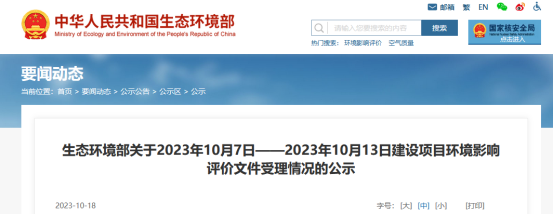On November 29, the Ministry of Ecology and Environment plans to review the environmental impact assessment document of the olefins, aromatics and deep processing project of Shaanxi Coal Group Yulin Chemical Co., Ltd.’s 15 million tons/year coal quality clean and efficient conversion demonstration project Announcement.
The project includes main engineering, storage and transportation engineering, public engineering, environmental protection engineering and supporting engineering. The main project includes 38 sets of production equipment such as coal pyrolysis equipment and pulverized coal gasification equipment; the storage and transportation project includes 6 circular closed coal bunkers, 173 storage tanks and 77 sets of unloading equipment; the public works include 6 supercritical boilers and 6 supercritical pump-back units (used as public heat sources in the park), etc.; environmental protection projects include 9 sets of waste gas/waste liquid incineration devices, 14 sets of wastewater pretreatment and 2 comprehensive sewage treatment plants, etc.; supporting projects include the park water supply project, the park Slag dumps, hazardous waste disposal projects, etc.
The total project investment is 175.973 billion yuan, of which environmental protection investment is 11.909 billion yuan, accounting for 6.77% of the project construction investment.
The main products of the project include polyolefin, polyester, degradable plastics, battery electrolyte, etc.
On October 18, the website of the Ministry of Ecology and Environment released an announcement on the acceptance of environmental impact assessment documents for construction projects from October 7, 2023 to October 13, 2023. Accepted projects include Shaanxi Coal Group Yulin Chemical Co., Ltd.’s 15 million tons/year coal quality clean and efficient conversion demonstration project olefins, aromatics and deep processing projects.

The main construction contents of the project include coal pyrolysis, gasification, methanol to olefins, diesel hydrogenation, aromatic deep processing, degradable plastics and battery electrolyte product equipment. The main equipment includes 13.5 million tons/year coal pyrolysis (including hydrogen pyrolysis ) unit, 5.6 million tons/year methanol unit, 1.48 million tons/year methanol-to-olefins unit, 31,500Nm3/h electrolysis water hydrogen production unit, 1.9 million tons/year diesel hydrogenation, 1.5 million tons/year aromatics reforming unit, 70 10,000 tons/year aromatization of young hydrocarbons, 2.2 million tons/year refined terephthalic acid plant, 2.4 million tons/year polyester plant, 260,000 tons/year polycarbonate, 300,000 tons/year polypropylene (PP), 300,000 tons/year polyethylene (FDPE), 400,000 tons/year polyacetic acid-vinyl acetate (EVA), 50,000 tons/year polyolefin elastomer (POE), 1 million tons/year dimethyl carbonate (DMC) , 220,000 tons/year super absorbent resin, 300,000 tons/year polybutylene terephthalate-adipate (PBAT), 67,800 tons/year biodegradable biomaterials (PBS), 30,000 tons /year tetrahydrofuran homopolyether (PTMEG), 210,000 tons/year ethylene carbonate (EC), 80,000 tons/year poly-3-hydroxypropionic acid (PPL), 330,000 tons/year polyether polyol, 700,000 tons /year propylene oxide, 150,000 tons/year ethyl methyl carbonate (EMC), 600,000 tons/year diethyl carbonate (DEC), 600,000 tons/year polypropylene carbonate (PPC) and other equipment and supporting facilities Engineering and auxiliary facilities produce more than 30 products, mainly resin materials, new chemical materials, degradable resins, and battery electrolytes. The total product volume is 8.7556 million tons/year, and the main product volume is 8.3172 million tons/year.
This project uses pulverized coal pyrolysis by-products to gasify methanol. Based on the basic chemical raw material of methanol, the methanol downstream is coupled with each other through the product chain, extending the product industry chain from three different directions. First, through large-scale MTO, olefin products are obtained and used as raw materials for high value-added chemical materials. The second is to use the gas phase methanol oxidative carbonylation method to produce high-purity DMC, and at the same time use the deep processing of DMC to produce diethyl carbonate (DEC) and ethyl methyl carbonate (EMC) electrolyte solvents to produce high value-added battery electrolytes; the third is Methanol is carbonylated to produce acetic acid, acetic acid is used to produce vinyl acetate, acetic acid and MTO olefin are coupled to produce new chemical materials such as vinyl acetate copolymer (EVA), and acetic acid is simultaneously hydrogenated to produce ethanol as the raw material for battery electrolyte EMC and DMC.

 微信扫一扫打赏
微信扫一扫打赏

